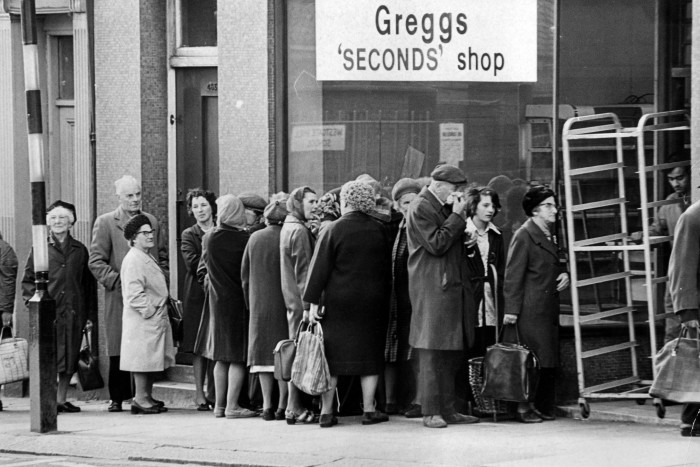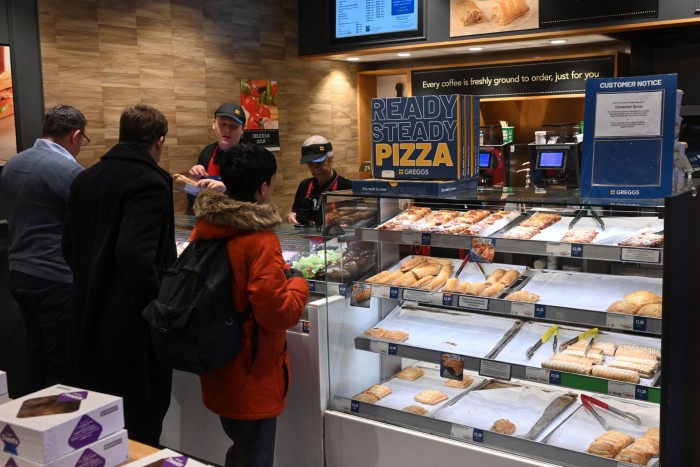After treating herself this week to a Greggs sausage roll in London’s financial district, sales executive Emily Morgan was quick to explain why the “comforting” food-to-go retailer was her lunch venue of choice over the countless nearby sandwich, sushi and supermarket options.
“Because that’s a rip-off, and that’s a rip-off,” she said, pointing at competitors lining the street, adding that now “people are less snobby” about the Newcastle-based bakery that is quickly eating up space in the UK’s high streets, service stations and transport hubs.
The FTSE 250 group has expanded rapidly over the past two years, achieving record market share as value-conscious consumers trade down to a brand whose heavily publicised move into vegan fare has challenged negative perceptions of the quality and healthiness of its food.
John Gregg opened the first Greggs shop on Newcastle’s Gosforth High Street in 1951 after taking over his family’s humble eggs, yeast and bread business. Just over 70 years later, the bakery has taken a record 8.2 per cent of the UK’s food-to-go market, where it has even knocked McDonald’s off the top spot for breakfasts.
The chain — whose savvy marketing efforts include a clothing partnership with Primark and handing “black cards” offering free food for life to stars Ed Sheeran and Stormzy — now takes almost £2 of every £100 spent on the UK hospitality sector, according to research by Hospitality Data Insights.
“They’ve almost built a little bit of a sub-community,” said Richard Lim, chief executive of consultancy Retail Economics. “They’ve built a fantastic brand that people value and enjoy”.
Greggs had reaped the benefits of keeping prices low, “as value has become a much more important driver of choice for consumers”, he added.
The company said this week that sales had risen almost 20 per cent last year to £1.8bn, bolstered by the expansion of evening trading and availability through “digital channels” such as Uber Eats and Just Eat, and that it was on track to double its sales in the five years to 2026.
The share price has followed that success, rising more than 60 per cent over the past five years.
As its ambitious expansion continues, it expects to open up to 160 new shops this year after 145 new sites in 2023 brought the total to 2,473, more than any other UK food retailer.
And with a target to achieve “significantly more than 3,000 shops in the UK over the longer term”, it has no plans to slow down, prompting analysts to ponder just how long its rise can continue.

Although the peak seems some way off, “if they want to continue this aggressive store opening plan they might be forced to take stores that don’t fit 100 per cent of their requirement”, said Lim.
“They’re going to find it harder to find the right stores in the right location at the right price while maintaining that kind of trajectory,” he added.
John Stevenson, a retail analyst at Peel Hunt, noted that part of Greggs’s physical expansion came down to increasing the size of its existing stores or relocating existing sites to larger premises nearby.
“You can look at the growth and store numbers, but actually within that there is an increase in the net space and some of the returns gained on the relocations are massive,” said Stevenson
Chief executive Roisin Currie, who took up the role a year and a half ago, noted that sometimes a relocation can be a matter of moving to a bigger space just next door.
“One of our shops in Runcorn . . . just by relocating next door in that shop we saw an immediate 30 per cent uplift in sales and we know that that shop can continue to grow,” she said.
She added that Greggs would look to relocate another 50 stores this year, and “that will be a similar number as we go forward”.
The front-of-house expansion, facilitated by an equally ambitious manufacturing surge behind the scenes, has required a surge in capital expenditure over the past two years.
Spending hit a record high of just under £200mn for 2023, up from a previous high of £110mn the year before and more than double any other year, although analysts have warned that it will have to come back down eventually.
The bakery chain on Tuesday announced two new production facilities: a frozen goods production and distribution centre in Derby that will employ about 1,000 people and supply Greggs stores around the country with sausage rolls and other products, and another in the Kettering and Corby area.
Meanwhile, there is ongoing expansion work in its Amesbury and Birmingham sites, which Greggs said would allow it to service an extra 300 shops, while a fourth production line in Newcastle’s Balliol Business Park is set to increase manufacturing capacity for “savoury rolls and bakes” by about 35 per cent.

Ownership of its manufacturing and distribution channels has given Greggs the freedom to experiment with and expand its product offering at a time of rapid changes in consumer preferences, while also making it easier to limit recent cost pressures.
“I’m sure that there’s a lot of development that doesn’t see the light of day but you’re able because you’re running your own production lines, and you can capture that margin,” said Stevenson.
As a result, with hungry shoppers increasingly opting for healthier options and vibrant flavour profiles, its new and improved stores are now lined with products very different to the offering 10 years ago, from salads to wraps.
However, the traditional sausage roll will still make up a “meaty” proportion of its sales, according to Lim.
Although the company’s growth will have to slow eventually, having reached the top of the UK food chain its appetite for expansion is larger than ever — and for now, neither customers nor investors can get enough of it.
“There’s no secret sauce. I can talk about the marketing, I can talk about the financial returns, I can talk about the night trade and breakfast market share and all the rest of it,” said Stevenson. “But fundamentally, the offer is absolutely nailed on . . . they know what their customers want.”












